Genome-wide prediction of metabolic enzymes, pathways and gene clusters in plants
 A considerable knowledge gap remains between the plant genome and the plant metabolome. To address this, Schläpfer et al. have developed a computational pipeline to identify metabolic enzymes, pathways, and gene clusters. Although metabolic genes are known to cluster in bacteria and fungi, until recently this phenomenon was not known to be widespread in plants. However, in just 18 species, the authors identified nearly 12,000 metabolic gene clusters. Many of these clusters include enzymes that produce a metabolite scaffold and enzymes that modify it. Their data also suggest that local gene duplication has contributed to the diversification of metabolic gene clusters. All the data can be browsed online at www.plantcyc.org. As the authors state, these tools can be used for “systematically cataloging the chemical diversity of plants and revealing Nature’s pharmacopeia in the green world.” Plant Physiol. 10.1104/pp.16.01942
A considerable knowledge gap remains between the plant genome and the plant metabolome. To address this, Schläpfer et al. have developed a computational pipeline to identify metabolic enzymes, pathways, and gene clusters. Although metabolic genes are known to cluster in bacteria and fungi, until recently this phenomenon was not known to be widespread in plants. However, in just 18 species, the authors identified nearly 12,000 metabolic gene clusters. Many of these clusters include enzymes that produce a metabolite scaffold and enzymes that modify it. Their data also suggest that local gene duplication has contributed to the diversification of metabolic gene clusters. All the data can be browsed online at www.plantcyc.org. As the authors state, these tools can be used for “systematically cataloging the chemical diversity of plants and revealing Nature’s pharmacopeia in the green world.” Plant Physiol. 10.1104/pp.16.01942


 The classic art of plant breeding involves carefully examining a genetically segregating population for traits of interest. Increasingly, high-throughput, automated phenotyping systems are being used; for example, robots can carry plants to imaging chambers for data collection. However, growth-chamber grown plants do not fully replicate the range of conditions experienced by field-grown plants. Tanger et al. describe the application of a field-based, high throughput phenotyping system for rice (based on one developed for cotton). The tractor-based system uses multispectral reflectance and ultrasonic sensors to measure canopy height, temperature depression, and several reflective ratios at a rate of 3000 plots/hr, as compared to 45 plots/hr for manual phenotyping. As a proof-of-concept, the authors identified four alleles with a negative effect on grain yield that are fixed in a modern cultivar (IR64); replacing these negative alleles should lead to yield improvements. Sci. Rep.
The classic art of plant breeding involves carefully examining a genetically segregating population for traits of interest. Increasingly, high-throughput, automated phenotyping systems are being used; for example, robots can carry plants to imaging chambers for data collection. However, growth-chamber grown plants do not fully replicate the range of conditions experienced by field-grown plants. Tanger et al. describe the application of a field-based, high throughput phenotyping system for rice (based on one developed for cotton). The tractor-based system uses multispectral reflectance and ultrasonic sensors to measure canopy height, temperature depression, and several reflective ratios at a rate of 3000 plots/hr, as compared to 45 plots/hr for manual phenotyping. As a proof-of-concept, the authors identified four alleles with a negative effect on grain yield that are fixed in a modern cultivar (IR64); replacing these negative alleles should lead to yield improvements. Sci. Rep. 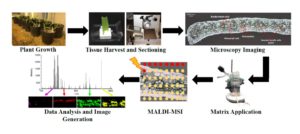 The distribution of metabolites in tissues can be determined in situ through the technique Mass spectrometry imaging (MSI) with matrix-assisted laser desorption ionization (MALDI) (also known as MALDI-MSI). Duenas et al. used MALDI-MSI to analyze the distribution of thylakoid membrane lipids in maize, specifically comparing those of the the bundle sheath cells and mesophyll cells. Maize has Kranz anatomy in which the chloroplasts of the mesophyll cells are specialized for light harvesting, and those of the bundle sheath cells are specialized for the Calvin-Benson Cycle. The authors found that SQDG (sulfoquinovosyldiacylglycerol) species are uniformly distributed in both photosynthetic cell types. By contrast, phosphatidyglycerol (PG) species show cell-specific localization. As an example, 16:0-containing PGs are mostly in bundle-sheath cells whereas 16:1-containing PGs are primarily in mesophyll cells and accumulate as the tissue develops and becomes photosynthetically active. These data demonstrate the power of MALDI-MSI for probing metabolism at the single-cell level. Plant J.
The distribution of metabolites in tissues can be determined in situ through the technique Mass spectrometry imaging (MSI) with matrix-assisted laser desorption ionization (MALDI) (also known as MALDI-MSI). Duenas et al. used MALDI-MSI to analyze the distribution of thylakoid membrane lipids in maize, specifically comparing those of the the bundle sheath cells and mesophyll cells. Maize has Kranz anatomy in which the chloroplasts of the mesophyll cells are specialized for light harvesting, and those of the bundle sheath cells are specialized for the Calvin-Benson Cycle. The authors found that SQDG (sulfoquinovosyldiacylglycerol) species are uniformly distributed in both photosynthetic cell types. By contrast, phosphatidyglycerol (PG) species show cell-specific localization. As an example, 16:0-containing PGs are mostly in bundle-sheath cells whereas 16:1-containing PGs are primarily in mesophyll cells and accumulate as the tissue develops and becomes photosynthetically active. These data demonstrate the power of MALDI-MSI for probing metabolism at the single-cell level. Plant J.  Plants produce a huge variety of specialized metabolites, many with roles in defense. Metabolic profiles rarely follow phylogenetic lines; in fact, closely related species often produce dramatically different suites of metabolites. When it comes to defense chemistry, it is advantageous to be different from your neighbor; species can carve out their own niche as a consequence of the pests and pathogens they can avoid. Sedio explores the use of comparative structural metabolomics to understand the role of specialized metabolites in community ecology. Specifically, he describes an approach that compares the structural similarity of unknown compounds from complex samples. By comparing thousands of structures from hundreds of plants, it should be possible to test the hypothesis that chemical diversity drives ecological coexistence of plant species diversity. New Phytol.
Plants produce a huge variety of specialized metabolites, many with roles in defense. Metabolic profiles rarely follow phylogenetic lines; in fact, closely related species often produce dramatically different suites of metabolites. When it comes to defense chemistry, it is advantageous to be different from your neighbor; species can carve out their own niche as a consequence of the pests and pathogens they can avoid. Sedio explores the use of comparative structural metabolomics to understand the role of specialized metabolites in community ecology. Specifically, he describes an approach that compares the structural similarity of unknown compounds from complex samples. By comparing thousands of structures from hundreds of plants, it should be possible to test the hypothesis that chemical diversity drives ecological coexistence of plant species diversity. New Phytol. 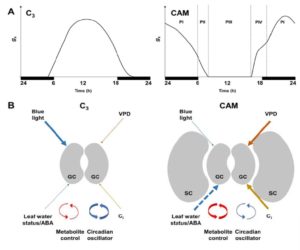 Crassulacean acid metabolism (CAM) plants open their stomata at night, decreasing water loss and increasing water-use efficiency as well as drought tolerance. Males and Griffiths review the stomatal biology of CAM plants as compared to C3 plants. For example, CAM stomata are relatively insensitive to blue light, which is a powerful opening stimulus for C3 stomata; conversely, CAM stomata appear to be more sensitive to plant water status and intercellular CO2 levels than C3 plants. However, deliniating differences between C3 and CAM stomatal biology is complicated by the fact that CAM is a convergent trait that has evolved independently many times in diverse lineages. Facultative CAM plants, which can switch from C3 to CAM when conditions warrant, are promising models. A key objective of these studies is to investigate the possibility of engineering facultative CAM into C3 plants to enable them to weather periods of drought. Plant Physiol.
Crassulacean acid metabolism (CAM) plants open their stomata at night, decreasing water loss and increasing water-use efficiency as well as drought tolerance. Males and Griffiths review the stomatal biology of CAM plants as compared to C3 plants. For example, CAM stomata are relatively insensitive to blue light, which is a powerful opening stimulus for C3 stomata; conversely, CAM stomata appear to be more sensitive to plant water status and intercellular CO2 levels than C3 plants. However, deliniating differences between C3 and CAM stomatal biology is complicated by the fact that CAM is a convergent trait that has evolved independently many times in diverse lineages. Facultative CAM plants, which can switch from C3 to CAM when conditions warrant, are promising models. A key objective of these studies is to investigate the possibility of engineering facultative CAM into C3 plants to enable them to weather periods of drought. Plant Physiol. 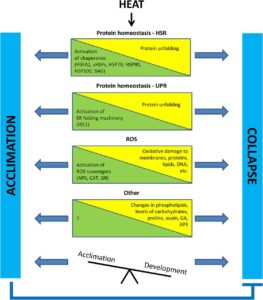 The seeds and fruits derived from the sexual reproduction of flowering plants constitute the major part of the human diet. Our capacity to generate sufficient crop yield is increasingly compromised by human population expansion, competition for land use, biodiversity loss, and global climate change. Hot days and heat waves are predicted to increase in frequency and intensity in many temperate regions in the coming decades as a consequence of global warming. Exposure to high temperature episodes often coincides with the reproductive phase of the plant life cycle. As pollen development and functioning are among the most heat-sensitive processes that impact upon plant fertility, it is crucial to understand the mechanisms and processes underlying heat-related male sterility in order to maintain food security.
The seeds and fruits derived from the sexual reproduction of flowering plants constitute the major part of the human diet. Our capacity to generate sufficient crop yield is increasingly compromised by human population expansion, competition for land use, biodiversity loss, and global climate change. Hot days and heat waves are predicted to increase in frequency and intensity in many temperate regions in the coming decades as a consequence of global warming. Exposure to high temperature episodes often coincides with the reproductive phase of the plant life cycle. As pollen development and functioning are among the most heat-sensitive processes that impact upon plant fertility, it is crucial to understand the mechanisms and processes underlying heat-related male sterility in order to maintain food security. “Smallholder farmers in eastern and southern Africa are facing a new threat as a plague of intrepid fall armyworms creeps across the region, so far damaging an estimated 287,000 hectares of maize.
“Smallholder farmers in eastern and southern Africa are facing a new threat as a plague of intrepid fall armyworms creeps across the region, so far damaging an estimated 287,000 hectares of maize.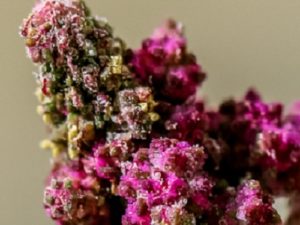 The high-quality sequencing of a quinoa genome brings new potential for global food security.
The high-quality sequencing of a quinoa genome brings new potential for global food security.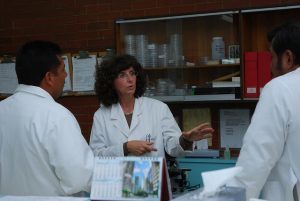 “A curiosity for disease and a passion to cure led Mezzalama to a career as a plant pathologist. While studying for an undergraduate degree in agronomy in her hometown of Turin, Italy, she visited nearby vineyards to study plant pathogens for the first time.
“A curiosity for disease and a passion to cure led Mezzalama to a career as a plant pathologist. While studying for an undergraduate degree in agronomy in her hometown of Turin, Italy, she visited nearby vineyards to study plant pathogens for the first time.